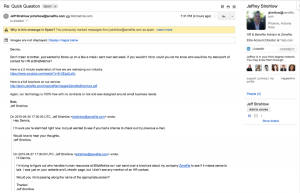
Translating your website into multiple languages (or even one language) can be a big undertaking. While we strive to make the actual translation process as smooth and carefree as possible, there is a lot more to preparing for a multilingual website than handing your existing website over to a translation partner with the direction “translate it.” There is much for the client to consider and decide upon before work even starts. But, when a multilingual website is well-planned and executed, the result can be well worth the effort and cost.
Follow these best practices for preparing multilingual websites and you are more likely to see the results you expect.
Do the research
You should first do some market research to determine what languages are most likely to give you the best opportunities for growth. There are plenty of resources available to help you evaluate the competition and determine where your products or services are likely to be most in demand. If you’re engaged in ecommerce, there are statistics about which languages have the most online buying power.
Design with translation in mind
If you’re creating or redesigning your website, you’re in the best position because you can make sure that the website design is responsive and that best practices for designing multilingual websites are followed from the beginning. This includes aspects of coding, writing, and graphic design. The website developer you use should be familiar with the needs of translation.
If you have an existing site and you’re not interested in a total redesign, there are still some things you should think about first before you simply ask for a price on translation.
- Adapt your design: If your website design is not already responsive, consider having the design adapted to be responsive or at least the creation of a mobile site. In some areas of the world, smartphones are the major way that people connect to the web, and their use is growing rapidly everywhere.
- Choose content for translation: Consider what parts of your site really need to be translated. What portions of your website are most likely to be important to people in other countries? Will you be selling all of your goods and services in other markets, or will you start with a limited offering? Do the foreign language sites need to show job opportunities, directions to your place of business, or frequently changing news items? Narrow this down before you get a price for translation to avoid unnecessary sticker shock.
- Get a cultural assessment: A pre-translation cultural assessment can help determine if there are any design elements or content that would cause difficulty for translation, either because of technical issues (like fitting content to a specific space) or for cultural reasons (such as the use of images that might not be meaningful or might even be offensive in other cultures).
Pick the right language partner
You will want to make sure that the partner you use for translation has experience not simply in translation, but also specifically in website translation and that they understand how to deal with the code involved. Your language partner should be able to knowledgeably interact with your web developer to work out the most efficient process for the translation based on the size of the site, the content management system used, and other technical factors.
Definitely do not rely on Google Translate. You won’t know when, for example, your reference to a “bank” with a word that means as the bank of a river.
Link sites through a language menu
When your sites are ready you will want them to link through a language menu that allows a user to pick the language they prefer. This may be a simple list of language links side by side if there are only a few languages, or it could be a pull-down menu. If you have a large number of separate language and/or country sites, the language menu might even have its own page. Whatever you choose, each language should be listed in its own language (in other words, Spanish should be “español” in the language menu on all versions of the site. You should not use flags to indicate languages. If you use flags, you risk, for example, inviting Spain while ignoring Mexico. Flags should only be used to mark links to sites that are dedicated to a particular country. It should also be easy for users to find the language option they want and to switch between them if they wish.
Plan for international SEO
Once your foreign language sites are up, you will want to make sure that prospective customers can find them on local search engines. That means that you should pay attention to multilingual SEO in the same way that you do for your local language site. More information on this topic is found in our earlier post “Guide to a Successful SEO Strategy,” so I will just restate the main points here.
- Specify your targets: Be clear about who your foreign-language sites are targeting—all speakers of a language or a particular locale.
- Choose your URL structure: You can structure the foreign language sites as subdomains of your main site, subdirectories, or separate URLs. Which you choose will depend a lot on what audiences the sites are targeting. Whatever you decide, be consistent. Use the same URL structure for all your foreign language sites to make it easier for search engines to relate them to each other.
- Decide where to host sites: If you are targeting specific countries or regions it may be preferable to host that particular foreign-language site in that country.
- Conduct multilingual keyword analysis: Don’t assume that direct translations of your existing keywords will give you the best keywords in other languages. You’ll want to find the best keywords for users in each language based on relevance and search volumes. Don’t just look at Google. Find out about the criteria of any other major local search engines such as Baidu in China or Yandex in Russia.
- Use the proper encoding: Make sure the proper character encoding is used (UTF-8 should handle any language) and specific the language and country in the html tag of your site. You should also use Google’s hreflang annotation in your HTTP header, HTML header, or XML sitemap.
- Make sure everything is translated: Search engines scan and use all content in evaluating your site including meta page titles, descriptions and keywords, descriptive tag attributes, and page URL addresses.
- Prepare for off-page SEO: backlinks from other sites in the same language, mentions in news media and social networks, and pay-per-click advertising to drive initial traffic play the same role in foreign markets that they do in the U.S. Plan a social media strategy based on the relevant local social networks.
- Plan for updates: a static site will tend to fall in rankings over time since search engines can’t be sure that the material remains relevant.
Multilingual sites done right aren’t easy, but doing them wrong can simply be a waste of money. Picking and choosing what to translate and when, and carrying out your plan incrementally can help with budget planning and minimizing costs while giving you the best possible change of international success.
(235)








